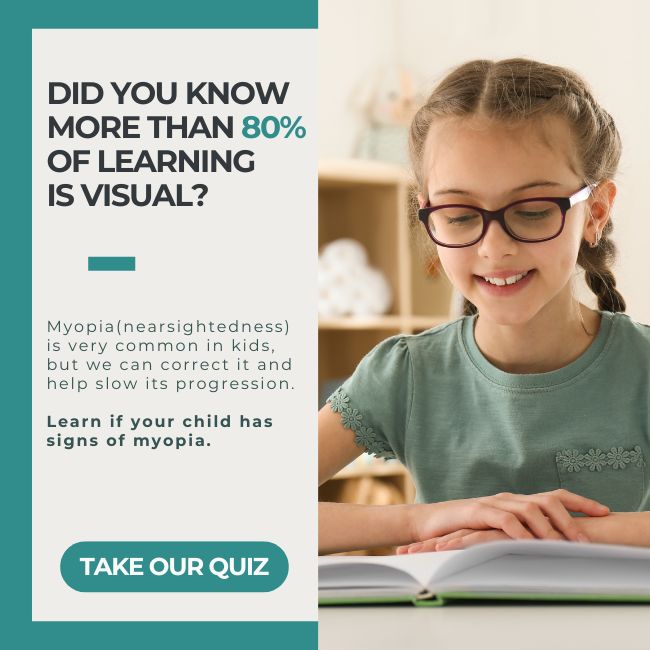Astigmatism is a common condition that can cause blurred or distorted sight at any distance. If you’ve been told you have astigmatism, you might be wondering whether contact lenses could be an option, and which type would work for you.
The good news is that many people with astigmatism can wear contact lenses. Toric lenses are the most common choice, but they’re not the only option. Your optometrist can help you explore lenses that fit your eyes, prescription, and lifestyle.
Understanding Astigmatism
Astigmatism occurs when the cornea (the clear front surface of your eye) or the lens inside your eye has an irregular curvature. Instead of being perfectly round, your cornea or lens is shaped more like a football, which causes light to focus unevenly on the retina. This can result in blurry or distorted vision.
Astigmatism is different from nearsightedness or farsightedness, though people can have more than one refractive error at the same time.
Causes of Astigmatism
Astigmatism often runs in families, but it can also develop from other factors, such as:
- Eye injuries
- Complications after eye surgery
- Keratoconus (a progressive thinning of the cornea)
- Pressure from the eyelids over time
Common Symptoms
The most noticeable symptom is blurry vision at both near and far distances. Other symptoms include:
- Halos or glare around lights
- Frequent squinting to see clearly
- Headaches
- Eye strain or fatigue
If you notice these symptoms, it’s worth booking an eye exam to check for astigmatism and other possible vision changes.
Toric Contact Lenses
Toric contact lenses are designed for people with astigmatism. They have different powers in different meridians of the lens to match the uneven curvature of your eye.
How They Work
Toric lenses need to remain in specific positions on your eye so that their curvature lines up with your astigmatism. This helps provide clearer, sharper vision compared to wearing standard lenses.
Benefits of toric lenses include:
- Effectiveness for astigmatism
- Improved clarity at multiple distances
- Availability in daily, bi-weekly, or monthly replacement schedules
Other Contact Lens Options for Astigmatism

While toric lenses are the go-to for many patients, we might suggest other types depending on your prescription, comfort needs, or eye health.
Gas-Permeable (RGP) Lenses
RGP lenses are small, firm lenses that maintain their shape on the eye. Because they don’t conform to the cornea’s irregularities, they can correct astigmatism very effectively. RGP lenses may take some time to get used to, but many patients appreciate the sharp vision they provide.
Hybrid Lenses
Hybrid lenses have a rigid gas-permeable (RGP) center surrounded by a soft lens “skirt.” The rigid center gives crisp, sharp vision, while the soft edge adds comfort. They can be a good choice for people who need the clarity of RGP lenses but want a softer feel.
Scleral Lenses
Scleral lenses are larger, rigid lenses that rest on the white part of your eye (the sclera) and vault over the cornea. They can provide excellent comfort and clarity, especially for people with irregular corneas or higher levels of astigmatism.
Factors to Consider When Choosing Lenses
Prescription Accuracy
We measure not only the strength of your prescription, but also the exact orientation (axis) of your astigmatism. This allows us to provide a prescription that matches the shape of your eyes.
Comfort & Fit
A lens that doesn’t fit well can cause discomfort, reduced vision quality, or even eye health issues. The right fit helps your lenses stay stable so your vision remains clear throughout the day.
Lifestyle & Activities
If you have a busy, active lifestyle, you might prefer the convenience of daily disposable lenses. If you also have presbyopia (age-related near vision changes), multifocal toric lenses could help you see clearly at multiple distances.
Pros & Cons of Different Lenses
Toric Lenses
- Pros: Widely available, designed specifically for astigmatism, available in soft lens materials
- Cons: May rotate slightly on the eye, which can affect clarity for some wearers
RGP Lenses
- Pros: Excellent clarity, long-lasting, can correct higher levels of astigmatism
- Cons: Smaller size can make them less comfortable at first, longer adjustment period
Hybrid Lenses
- Pros: Sharp vision like RGP lenses with much of the comfort of soft lenses
- Cons: Typically more expensive, require special care
Scleral Lenses
- Pros: Very stable on the eye, comfortable for many wearers, great for irregular corneas
- Cons: Higher cost, requires more care and handling
Why a Professional Fitting Matters
Unlike standard contact lenses, lenses for astigmatism require more precise measurements to see that the correction is aligned correctly. A professional fitting includes:
- Measuring the shape and size of your cornea
- Assessing your tear film and eye health
- Testing trial lenses for comfort and clarity
- Making adjustments to improve fit and vision
The Next Step: Booking Your Eye Exam
If you have astigmatism and want to explore contact lenses, a good place to start is with a comprehensive eye exam. During your appointment, we can confirm your prescription, recommend the right lens type for your eyes, and let you try different lenses to see what feels and looks great to you. At Insight Eyecare, we take the time to match you with lenses that support both your vision and comfort. Whether you choose toric lenses, hybrid designs, or something else, our goal is to help you see clearly and confidently. Book your eye exam with us today and take the first step toward sharper, more comfortable vision.







